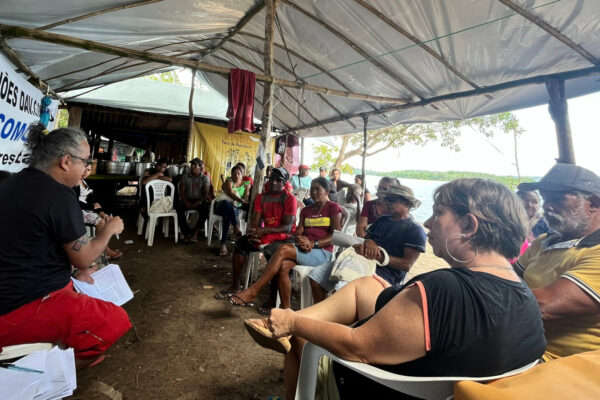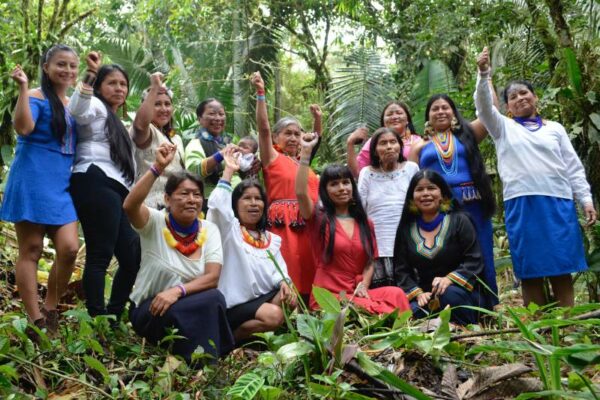Environmentalists, indigenous groups, rocks stars and Hollywood heavy-hitters have had it in for the Belo Monte hydroelectric dam project since Brazil’s military dictatorship schemed up the idea some 30 years ago. Over the decades the name of the project has changed along with its design and principle source of financing, but the Brazilian government’s insistence of damming the Xingu River in the heart of the Amazon to produce energy has remained steadfast, as has grass roots resistance.
The Brazilian government argues that it’s about the progress of a nation, the development of a region long forgotten and the need to prevent rolling blackouts in the world’s 6th largest economy. Environmentalists and human rights advocates charge back that it’s a disastrous project for the Amazon, one that will not only scar the rainforest’s magnificent ecology, but it will displace tens of thousands of people, adversely affect indigenous communities and throw an already troubled city, Altamira, into chaos.
The government makes assurances that the environmental and social impacts of the 11,000 megawatt dam will be minimal. Opponents of the project point to the 40,000 hectares of Amazon rainforest that will be flooded, the massive deforestation that will occur, and the resulting loss of biodiversity, including rare endemic fish species, as the waters of the massive basin of the Xingu’s Volta Grande (Big Bend) are drained as a more sobering social and ecological scenario for what’s at stake. Having approved the project without a full environmental impact’s assessment, the Brazilian government is in turbid waters to be able to placate environmental concerns.
As construction of the dam began in March of 2011, protests ramped up, and headaches worsened for the government and for Norte Energia, the consortium heading the dam’s construction, Apart from the usual pickets and petitions, the dam site was invaded twice. On June 15th 2012, one week before Brazil played host to the United Nation’s Rio+20 Earth Summit, a coalition of indigenous groups, local residents, farmers and environmentalists armed with pick axes and shovels spent ten hours on site excavating a canal through one of Belo Monte’s newly land-filled coffer dams, allowing part of the Xingu River to flow freely once again; although just briefly.
The second invasion was led by indigenous groups and was anything but brief. Incensed over having been ignored and deceived, and after exhausting long standing attempts to have their concerns addressed, over 300 indigenous peoples from 16 different tribes including the Xikrin, Arara and Juruna occupied a section of the $16 billion mega project for three weeks, bringing work on the strategic Pimental coffer dam to a standstill.
Their occupation forced the President of Norte Energia Carlos Nascimento to call for and facilitate an emergency 3-day summit with involved indigenous groups to negotiate an end to the occupation. Cars, computers, digital cameras and other trinkets were on the table and would be delivered in weeks in exchange for the indigenous protesters liberating the dam. The President of Norte Energia wouldn’t address long-term concerns or make promises regarding the future of these groups in the region. “That, when pushed would have to come later,” he said.”Trust me.”
A deal was struck, and the dam liberated, but not all were happy with the “divide and conquer” feel to the negotiations. Biviany Rojas, a lawyer with the Instituto Socioambiental (ISA)
in Brazil observed that “the negotiation process was unequal, totally asymmetric. You have a multi billion dollar company sitting up in front of various indigenous groups who it is dividing. The company makes up the rules of the negotiations as it likes, without any intervention by a government that is mostly absent from the entire process.”
Contrary to what Norte Energia and the government had hoped, this accord would not end its headaches on Belo Monte.
Weeks later, judges from one of Brazil’s 5 regional appellate courts (TRF-1) ordered construction of the dam suspended on grounds that indigenous groups had not been properly consulted -as guaranteed by the Brazilian constitution – before
Congress approved the project back in 2005. This move didn’t simply paralyze a part of the construction; it put the brakes on the entire works.
Norte Energia was forced to suspend all activities related to the construction of the dam or face a $ 250,000 a day fine. The dam’s opponents were elated, but cautiously so.
As one often suspects in Brazil, powerful judges cozy with powerful political forces are just a phone call away. In a matter of days following the appellate court’s order, while headlines were still breaking around the globe, Chief Justice Carlos Ayres Britto of the Brazilian Supreme Court unilaterally overturned the decision, liberating construction once again.
Brent Millikan, Amazon Program Director at International Rivers lamented: “This case is emblematic of a seriously flawed legal system, where bureaucracy and political interventions allow for systematic violations of human rights and environmental law”.
Naturally, Justice Carlos Ayres Britto’s decision is also being appealed.
Headaches are far from over for Belo Monte. There are 15 further legal matters before the courts, and all indications are that indigenous groups and environmentalist will continue nipping at Norte Energia’s heels for every illegally fallen tree and every broken promise. Adding to this are brewing union and worker issues as recent strikes have demonstrated.
All this begs the question: is this the only way to produce energy in Brazil? Brazil has built 4 large dams in the Amazon; all have come with hefty financial price tags and even heftier social costs. Still, this appears to be the path Brazil wishes to blaze. Belo Monte is just one of 60 hydroelectric projects that the government is keen to build in the region under their Growth Acceleration Program (PAC) over the next 20 years.
Between 80 – 90% of all energy in Brazil is hydroelectric, and since hydroelectric energy is considered renewable and “green” – even embraced by some environmental groups, the Intergovernmental Panel on Climate Change and the World Bank – Brazil boasts one of the best track records for the production of green energy in the global race to wean off of climate change provoking fossil fuels.
Some say not so fast. Philip Fearnside, a leading climate scientist from the National Institute for Amazon Research (INPA), is one researcher trying to debunk the superhero green status given hydroelectric dams of late.
“Hydroelectric dams are always, or almost always, presented as green energy. [Claims are] it doesn’t have any impact over global warming, and people have heard that so many times that they believe it. They’ve not heard any other information. Unfortunately dams also emit greenhouse gases”.
When an area of forest is flooded, the decaying vegetation and forest matter produces methane (CH4). Methane is a greenhouse gas 25– 34 times more potent, per ton, as a heat trapping agent than carbon dioxide (CO2).
Researchers at Brazil’s National Institute for Space Research (INPE) estimate that the world’s 52,000 large dams produce 104 million metric tons of methane each year, about 4% of the total global warming impact produced by man.
Fearnside suggests that it’s not just the initial flooding that will generate methane with Belo Monte. Because the Xingu’s waters rise and drop dramatically because of the seasons, new biomass will grow on areas and river beds exposed during annual dry seasons, only to be flooded later spewing more methane. He calculates that given all the methane released it would take 41 years before Belo Monte would have any real green attributes. “It’s very important to take measures against global warming now. You can’t sell hydroelectric dams as green energy and good for global warming when it isn’t going to be doing anything for the next 41 years.”
Instead of dams, environmentalists and scientists point to other abundant renewable sources like solar energy.
Brazil is a world leader in solar incidence, meaning the amount of solar energy striking its surface, according to Greenpeace’s report Energy Revolution Scenario in Brazil.
A sustainable world energy outlook, Brazil’s average annual global radiation is nearly 23,000 kilowatts per square meter. Harnessing just 5% of this energy could meet all of Brazil’s energy demands.
Brazil also has an abundance of silicon, the principle material needed in the production of photo voltaic cells (PVs) for capturing solar energy.
Of late, moves made by the Brazilian government are creating a bit of excitement for solar energy advocates and enthusiasts. They recently gave the nod to residential and commercial entities to install solar equipment and sell electricity back to the grid for projects up to 1 MW capacity. And Brazil’s National Development Bank (BNDES), currently financing up to 80% of Belo Monte’s $16 billion price tag, has indicated it is prepared to make concessions on its overwhelming support for Amazon dams and help fund large solar projects in the country.
ANEEL (Brazil’s electricity regulatory Agency) called for the submission of solar energy projects in 2011 for evaluation, and has since given the thumbs-up to 18 different ventures over the next 3 years. The projects have a combined investment of approx. US$200 million and will have a production capacity of 25MW.
So there’s some movement, but not nearly as much as advocates feel is warrant given Brazil’s potential, and more importantly, the social and ecological consequences of continuing to dam the Amazon.
“While recent moves to diversify its energy matrix are encouraging, Brazil’s deck remains heavily stacked in favor of big and unacceptably destructive hydroelectric projects in the Amazon,” says Christian Poirier of Amazon Watch. “Solar and wind energy comprise a meager 2% of the matrix in a country that has both the potential and responsibility to be a true alternative energy leader for the 21st century.”
They point to Germany’s recent record-breaking achievement with solar energy to argue that Brazil is simply dragging their feet on the issue and ignoring the future.
During a Friday and Saturday afternoon in May of this year, Germany produced 22 gigawatts of electricity per hour thanks to the sun and their nation’s solar foresight; Germany has more solar installations than the entire world combined. The country generated 22 gigawatts of energy, the energy equivalence of 20 nuclear power plants as press releases stated, producing close to 50% of the nation’s energy needs on those afternoons.
When pushed by opponents of big dams in the Amazon, the president of Brazil, Dilma Rouseff infamously quipped that those who think Brazil could produce the energy needed on alternative energy alone were living in a “fantasy” realm.
Someone should mention that to Chancellor Merkel of Germany.
The construction of Belo Monte appears to be a foregone conclusion, yet social movements, indigenous peoples, and environmental groups continue to resist the project as the harbinger of further disaster in the Amazon.
This begs the question: does the government really want to repeat this catastrophe another 60 times? With all its legal shenanigans and deferred justice, its heavy-handed disregard of intensifying international condemnations? How many more dark episodes of indigenous rights violations, environmental degradation, and political corruption does a nation have endure, and how many more disastrous dams must be built, before we see the light, and better yet, let it finally shine in and power the nation?













